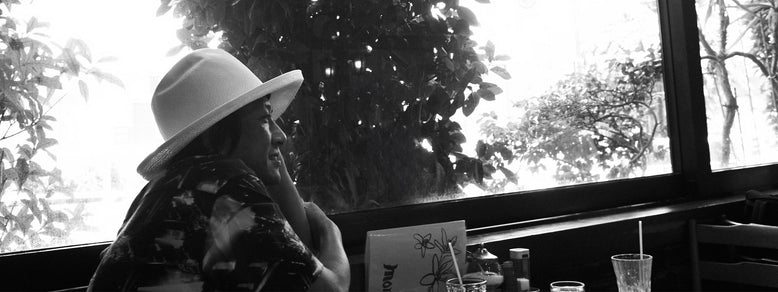Masatoshi Shinagawa Reflects on Kyoto,
the Crossroads of History and Culture
Shinmonzen Street, running east to west through the Higashiyama Ward of Kyoto, a city visited by tourists from around the world, still maintains the traditional atmosphere and charm of the old townscape. MOMOTARO JEANS' new flagship store, MOMOTARO JEANS KYOTO, is located in a corner of this tranquil neighborhood. The store is a renovated machiya (a type of traditional Japanese townhouse), designed by the architectural unit AS. "I didn't want to cut off the building’s history," said architect Masatoshi Shinagawa, who leads AS alongside Jun Aoki. We have explored the true meaning behind these words, and taken a look behind-the-scenes of how this unique space came to be.
Photographs : Masashi Ura
Editing & text : Rui Konno
A Kyoto Machiya is Reborn

―It only opened half a year ago, but it already blends into Kyoto's townscape as if it has always been there.
Shinagawa: This building is actually a traditional machiya that's over 70 years old. Until recently, it was an actual home that had evolved over time to meet the needs of its residents. We want to preserve these traces of life while adding a new layer of history.
―I see. Now that you mention it, I can sense vestiges of that past here and there.
Shinagawa: Yes, indeed. Nevertheless, it has changed dramatically from its original form. When we first received the offer, it was already decided that we would be renovating a machiya in this location, so we said, "Let's actually go see it." At that point, it had been vacant for several years, with exposed dirt floors and a dusty, dark interior. But there was a small skylight—which we have worked into the current shop—through which light was streaming in, making me think it could become something attractive.
―Was this an unusual project for AS?
Shinagawa: Yes. This was our first hands-on project with a traditional Kyoto machiya, so we relied heavily on the expertise of our contractors. We worked with Kisyo, master craftspeople specializing in Kyoto machiya construction. They taught us techniques like ash leaching—a traditional method they used to transform these wooden pillars from pitch black with iron oxide to the lighter, natural finish you see today.


―It looks so natural, as if it looked like this from the beginning.
Shinagawa: If you look up when you're in the store, you can see some pillars and beams that are still pitch black, which is how you can tell. On the other hand, the pillars attached to the walls are new additions. They were originally bright, clean wood, but we applied kakishibu paint (traditional Japanese persimmon tannin) to give them a subdued color, ensuring they don't contrast too strongly with the older pillars. We learned each and every one of these techniques from Kisyo’s craftspeople.
―So even for people like yourself, who have been involved in architecture for years, this was quite a new endeavor?
Shinagawa: The MOMOTARO JEANS KYOTO project was completely different from our usual work. Unlike modern buildings with CAD-precise measurements, this historical structure revealed its secrets only as we peeled back its layers. The traditional construction methods were new territory for us, so we adopted an on-site collaborative approach with the carpenters. No matter how meticulously we prepared drawings at the office, they could never be followed exactly as planned.
―It's amazing that these pillars supporting the entire building are just resting on stones.
Shinagawa: When we first examined the building, I was shocked to discover several pillars that weren't even touching the ground—they were literally floating! When I mentioned this to local Kyoto architects, they just laughed and said, "That's perfectly normal here!" (laughs). What makes Shinmonzen Street special is how it preserves an authentic atmosphere where shops selling ezoshi (traditional illustrated storybooks) and antiques coexist with everyday local life. I wanted to take this atmosphere to heart. Though it's near the tourist hub of Gion, it maintains a distinctive tranquility. Preserving this unique character became central to our approach.

―The mood around Kyoto changes wherever you go, despite being one big city. Was it difficult for you to understand the unique character of this area?
Shinagawa: In terms of my connection with Kyoto, we had been working on the renovation of the Kyoto City KYOCERA Museum of Art for about four or five years, so we were familiar with this area. And although they differ greatly in scale and structure, both projects involve renovating buildings that are over 70 years old. In that sense, we felt a connection with the area.

A Traditional Japanese Courtyard Connecting Kyoto and Kojima
―But a building from 80 years ago would be far from meeting current earthquake resistance standards, right?
Shinagawa: Major structural changes would have triggered compliance requirements with modern building codes, so we deliberately minimized structural interventions to avoid this. Meeting current standards would have meant completely redesigning the fire protection and structural systems, which would have erased the building's authentic character and severed its historical continuity.
―It would be a shame to lose that unique character. I think it's a space that intrigues not only Japanese people but also visitors from abroad.
Shinagawa: Yes. However, to be honest, we didn't particularly focus on that aspect. MOMOTARO JEANS representatives told us at the beginning, "We don't want to make it too obviously ‘aimed at tourists.’ That would make it feel like a souvenir shop." They said, "Rather than emphasizing stereotypical Kyoto-ness, please approach it more straightforwardly." That was liberating and allowed us to experiment with various approaches.
―What stands out the most is definitely the fitting rooms.
Shinagawa: The back area originally featured a small courtyard-like garden that had been partially filled in when bathroom and plumbing facilities were added over the years. We restored this garden space to its original purpose. At first the clients said they wanted “well-designed fitting rooms,” but this presented quite a challenge—fitting rooms require enclosure, take up valuable space, block sightlines, and can create a heavy presence in the space. Our solution was this configuration where the doors are kept open when not in use, creating a space that extends all the way through to the courtyard. When customers use the fitting rooms, it becomes like a private garden, and since the back walls are transparent, you get a completely unobstructed view from the entrance. Jun initially suggested, “How about having customers enter the store through the courtyard?” (laughs)

―(Laughs) So the space took shape through the exchange of ideas between you and Mr. Aoki.
Shinagawa: Yes. I'm quite direct and speak my mind with Jun. He is the type of person who listens to other people's opinions. Not just mine, he also wants to hear from staff members, and he doesn't mind being challenged or contradicted.
―I think it is quite remarkable to be able to exchange opinions as equals despite being more than a generation apart in age.
Shinagawa: I think Jun believes that ideas from just one person don't become that interesting. He's always thinking about what can be done within given conditions, which is why he needs people to talk with and welcomes criticism. People might imagine that in an architectural design office, the head sets the concept and everyone else follows along, but that's not how we operate.
―This courtyard is a product of that process. There is quite an impressive tree—is it a sago palm?
Shinagawa: Yes, it is. Previously, when Jun and I visited Kojima and were shown around by the MOMOTARO JEANS team, we saw a magnificent sago palm in the garden of the Nozaki Family Historic Residence across from their main store. It was the mansion of someone who had made his fortune in salt production, and the exotic sago palm, which seemed to have come from a southern country, apparently suited the Setouchi climate well. We wanted to carry over that atmosphere from Kojima to Kyoto through the courtyard. Interestingly, Nijo-jo Castle also has a room called the Sotetsu-no-ma (Sago Palm Room), with sago palms planted in its garden. It's something common to both Kyoto and the Setouchi region, and as an imported item from overseas, it also connects to denim in a way.
―So there were associations with the brand and product identity as well.
Shinagawa: Yes. MOMOTARO JEANS KYOTO was a project that really made us think about these things. The first thing we felt was that simple approaches, like just adding new materials to contrast with a traditional house, wouldn't quite work here. This machiya had undergone repairs until recently, so it already contained newer wooden elements as well as old wood and earthen walls. The old and new elements were already intermingled, and we added clearly new materials like acrylic lighting, aluminum fixtures with presence, and materials treated with kakishibu paint to resemble aged wood—creating a space where you can't immediately tell what was originally there and what is new. We felt this patchwork-like blend of old and new, where you can't definitively say that what was originally there is old and what we installed is new, seemed most appropriate.
The Story Continues From Here


―It's a mismatch that somehow harmonizes perfectly.
Shinagawa: I think denim, which MOMOTARO JEANS produces, exists in a world often defined by notions of "authenticity" - American authenticity, vintage authenticity, and so on. The same goes for Kyoto. When we heard their rebranding vision, I sensed they wanted to maintain a comfortable distance from all these existing notions of "authenticity." That is why we put the most care into finding the right balance - not being too conscious of denim authenticity or Kyoto authenticity, while also avoiding creating a space completely disconnected from them. It's about having respect for existing elements without being overly reverent. When considering how to engage with something that has inherent appeal, we first wanted to approach it simply as what's in front of us and what exists there - nothing more, nothing less.
—It's interesting how the space feels spiritually significant yet remains extremely practical in terms of functionality.
Shinagawa: For example, with denim, no matter how much philosophy is behind it or how good it looks, it still needs to function well as clothing, right? I felt the store needed to embody this same principle. I understood MOMOTARO JEANS' attitude of appreciating how materials age while maintaining their original colors and textures, so rather than applying heavy makeup, we aimed for a space where everything appears in its natural state yet remains beautiful.
—After hearing your explanation and looking around again, this space really feels like it embodies both the timing of the rebranding and the necessity of its Kyoto location.
Shinagawa: I think stores that maintain continuity with their environment, city, and context are much more enjoyable to visit. There are plenty of stores designed as theatrical spaces, completely disconnected from their surroundings, but I find shops that naturally connect with the streetscape much more appealing.

MOMOTARO JEANS KYOTO
256-2 Umemoto-cho, Shinmonzen-dori Yamato-oji Higashi-iru 3-chome, Higashiyama Ward, Kyoto City
TEL 075-708-7520
OPEN 11:00 - 19:00

PROFILE
Masatoshi Shinagawa
Born in Tokyo in 1982. After completing his master's degree in Architecture at the Tokyo University of the Arts, he joined Jun Aoki & Associates in 2008. He later served as chief at the firm, and in 2020, the office was renamed AS, which he has since co-directed with Jun Aoki. He has been involved in a variety of architectural works and facilities, including the Louis Vuitton Fukuoka store, the Kyoto City Museum of Art, and the Senkoji Peak Observatory.









